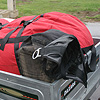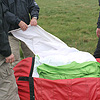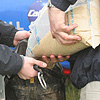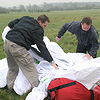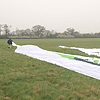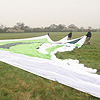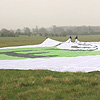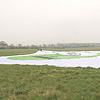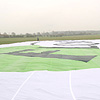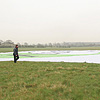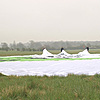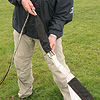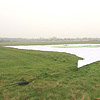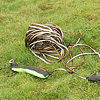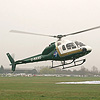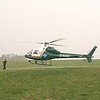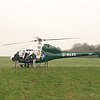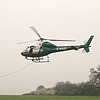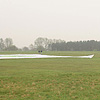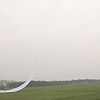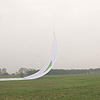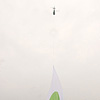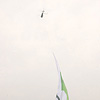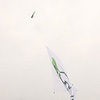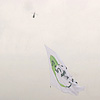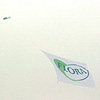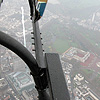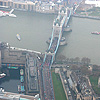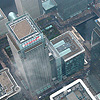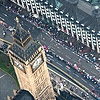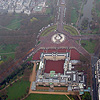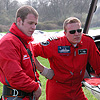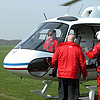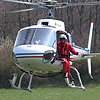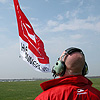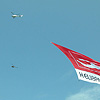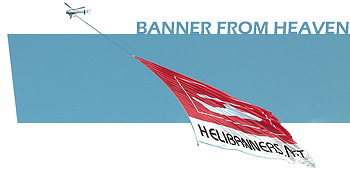
Helibanner Feature Report
Sunday 23rd April
The traditional image of a flying banner is that of a plain strip with a few words of text on it, towed by a light aircraft. Technology has moved on considerably since they were first invented and the new way to catch the public's attention is with a full colour banner of over 25,000 sq ft! There is more to it than meets the eye though, it's a well oiled system that has been developed over several years and has safety in mind.
visited a damp Elstree to witness a Helibanner take to the air.
One day I was sitting at my desk on the 13th floor and looked up to see what looked like a huge silk handkerchief floating above London, advertising Qantas. You can't help but be impressed by these huge flying billboards being towed by what looks like a minute helicopter in comparison. In fact you see the banner long before you see what's towing it.
I had to find out more about them and how they operate so I contacted the operators Cabair at Elstree. They fly the banners on behalf of Helibanners, the company that makes the banners and the associated rigging to fly them.
On the day of the London Marathon the sponsor, Flora, were due to have a banner flown over the event. So, on a rather damp Sunday morning when the ideal place to be would still be in bed I was at Cabair's HQ at Elstree to find out exactly what is involved in lifting one of these behemoths into the sky.
Surprisingly the weather minima for flying is not really different to the normal operation of the helicopter, a cloudbase of 1,500ft is preferable and visibility of 2.5 miles which wasn't far off what we were experiencing.
The procedure starts with unpacking the banner. They are manufactured in Australia and air freighted to the UK. The CAA has granted Helibanners permission to operate in the UK thanks to all the research and development in Australia over several years that has been refined into the system in operation today. They are a rapidly expanding phenomenon and are used in many countries worldwide and set to become a familiar sight at major events.
The banner is made of a thin, lightweight material, similar to the envelope of a hot air balloon. This particular banner has a total weight of around 100kg but rain can of course increase this. There is an art to packing the thing, the unpacked banner certainly doesn't look like it could fit in the bag! The banner is stretched out flat over the ground and the Flora banner is around 12,000 square feet although they can be made up to 45,000 square feet and in different proportions.
The bottom of the banner has a weight of around 100kg attached to stabilise it in flight. This is filled with fine sand and held in place with velcro. The rigging is quite an ingenious system, in an emergency the banner can be dropped but instead of having the banner and heavy weight tumbling out of the sky, the sandbag inverts and empties out the contents and the line that attaches to the helicopter deploys a parachute so the whole thing gently floats to the ground.
Once the sandbag and line are in place the helicopter moves into position. The model of choice is a Twin Squirrel which is ideal for the job of flying over central London and other built-up areas where the banners operate.
The banner is then attached to the helicopter and an observer looks out from the rear of the cabin to guide the pilot in the lift. The helicopter slowly rises and lifts the banner into the air. On a still day like we were experiencing it takes a little time for the banner to actually start flying properly as the helicopter accelerates to 30 knots and away towards London. Some banners fly better than others and it has been said the Qantas banner flies best of all.
The Flora banner was scheduled to fly for three hours before returning for another job, the endurance of the Twin Squirrel and banner being greater than if it were carrying passengers and flying at usual cruise speeds.
After seeing it fade into the murk I returned home to East London to see the banner flying proud overhead. On its return the banner is lowered to the ground and then detached from the helicopter but with the wet weather the packing of the banner can wait for another day!
